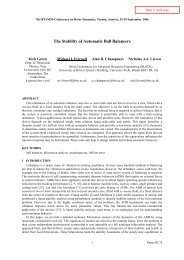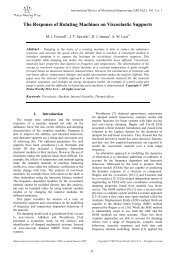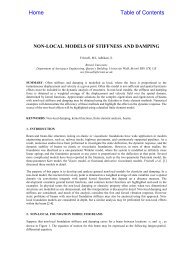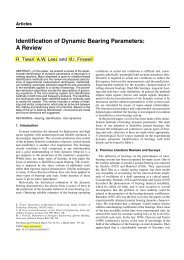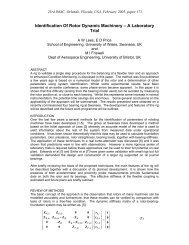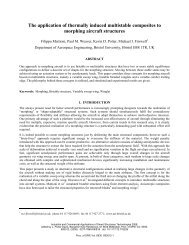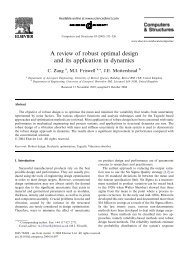Optimal Design of Elastomer Composites for ... - Michael I Friswell
Optimal Design of Elastomer Composites for ... - Michael I Friswell
Optimal Design of Elastomer Composites for ... - Michael I Friswell
You also want an ePaper? Increase the reach of your titles
YUMPU automatically turns print PDFs into web optimized ePapers that Google loves.
x 10 5<br />
Lamina E1, (MPa)<br />
2.5<br />
2<br />
1.5<br />
1<br />
0.5<br />
0<br />
Boron<br />
SiCon<br />
GrpHS<br />
Al2O3<br />
Safil<br />
GrpAS<br />
Kev49<br />
Glass<br />
Fibers Kev29<br />
RP6444urtn<br />
Ritflx640A<br />
Arntel640A<br />
Tecflx100A<br />
RP6442urtn<br />
RP6410urtn<br />
Tecflx080A<br />
Silcoruber<br />
<strong>Elastomer</strong>s<br />
(a) LONGITUDINAL YOUNG’S MODULUS<br />
Major Poissons ratio v 12<br />
0.7<br />
0.6<br />
0.5<br />
0.4<br />
0.3<br />
0.2<br />
Boron<br />
SiCon<br />
GrpHS<br />
Al2O3<br />
Safil<br />
GrpAS<br />
Kev49<br />
Glass<br />
Fibers Kev29<br />
RP6444urtn<br />
Ritflx640A<br />
Arntel640A<br />
Tecflx100A<br />
RP6442urtn<br />
RP6410urtn<br />
Tecflx080A<br />
Silcoruber <strong>Elastomer</strong>s<br />
(a) MAJOR POISSON’S RATIO<br />
400<br />
Lamina E2, (MPa)<br />
300<br />
200<br />
100<br />
0<br />
Boron<br />
SiCon<br />
GrpHS<br />
Al2O3<br />
Safil<br />
GrpAS<br />
Kev49<br />
Glass<br />
Fibers Kev29<br />
RP6444urtn<br />
Ritflx640A<br />
Arntel640A<br />
Tecflx100A<br />
RP6442urtn<br />
RP6410urtn<br />
Tecflx080A<br />
Silcoruber<br />
<strong>Elastomer</strong>s<br />
(b) LATERAL YOUNG’S MODULUS<br />
FIGURE 2. MODULUS PROPERTIES OF LAMINA FOR VARI-<br />
OUS FIBER AND ELASTOMER MATERIALS FOR STRAINS LESS<br />
THAN 25%<br />
Minor Poissons ratio v 21<br />
5<br />
4<br />
3<br />
2<br />
1<br />
x 10 −3<br />
0<br />
Boron<br />
SiCon<br />
GrpHS<br />
Al2O3<br />
Safil<br />
GrpAS<br />
Kev49<br />
Glass<br />
Fibers Kev29<br />
RP6444urtn<br />
Ritflx640A<br />
Arntel640A<br />
Tecflx100A<br />
RP6442urtn<br />
RP6410urtn<br />
Tecflx080A<br />
Silcoruber <strong>Elastomer</strong>s<br />
(b) MINOR POISSON’S RATIO<br />
FIGURE 3. POISSON’S RATIO OF LAMINA FOR VARIOUS<br />
FIBER AND ELASTOMER MATERIALS FOR STRAINS LESS<br />
THAN 25%<br />
HOMOGENISATION-BASED MULTI-SCALE CONSTITU-<br />
TIVE MODEL<br />
The main assumption in the homogenisation-based multiscale<br />
constitutive theory <strong>of</strong> heterogenous solids is that the macroscopic<br />
or homogenised strain tensor ε at any arbitrary point x <strong>of</strong><br />
the macroscopic continuum is the volume average <strong>of</strong> the microscopic<br />
strain tensor field ε µ defined over a local representative<br />
volume element (RVE). The RVE is such that its domain Ω µ has<br />
a characteristic length much smaller than that <strong>of</strong> the macroscopic<br />
continuum and, at the same time, is sufficiently large to represent<br />
the mechanical behaviour <strong>of</strong> the heterogeneous medium in the<br />
averaged sense.<br />
At any instant t, the macroscopic or homogenised strain ten-<br />
sor ε at a point x can be expressed as<br />
ε(x,t) = 1<br />
V µ<br />
∫<br />
Ω µ<br />
ε µ (y,t)dV, (2)<br />
where V µ is the volume <strong>of</strong> the RVE associated to point x, y denotes<br />
the local RVE coordinates and ε µ = ∇ s u µ , with ∇ s denoting<br />
the symmetric gradient operator and u µ the RVE (or microscropic)<br />
displacement field.<br />
Further, it is possible to decompose the displacement field<br />
u µ as a sum <strong>of</strong> a linear displacement ε(x,t)y, which represents<br />
a homogeneous strain, and a displacement fluctuation field ũu µ ,<br />
4 Copyright c⃝ 2011 by ASME




